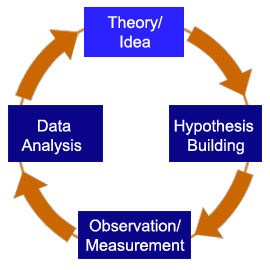Main Content
Lesson 2: Theory and Criminal Justice Research
Theory or Idea

The first component of the model is Theory or Idea. A theory is defined as an organized set of ideas that generate conceptual relationships about social reality. Obviously, social reality is what the scientific model is trying to shed light on. Our theories are our best guesses as to that reality, and as guesses have no empirical weight to them until they are scientifically tested. The first stage in this process boils down to clearly establishing the nature of the relationship(s) between social phenomena.
Let’s look at Shaw and McKay’s theory of Social Disorganization from 1942 as an example. Shaw and McKay, sociologists of the famed Chicago School of the 1960’s, were two of the first criminologists to geographically map criminal offenses. They used a pushpin map to locate serious offenses in the city of Chicago for one year and found pockets of concentrated criminal activity in certain city zones or neighborhoods. Now any beat cop or observant city resident could have told you what parts of the city were "bad" or "crime prone," but Shaw and McKay wanted to explain why those zones were so crime-riddled. They noticed that these crime-heavy zones were also areas of frequent population turnover -- they were characterized by run-down rental housing, poor quality of life, businesses which catered to a transient population, and general disorder. Shaw and McKay believed that these were symptoms of an overall breakdown in neighborhood informal social controls; the transience meant neighbors didn’t get to know one another well, 'strangers' were not seen as strangers in the neighborhoods, and people kept to themselves waiting until they had the resources to move to a more attractive community. The two scientists characterized neighborhoods of this type as "disorganized," thus forming the basis for their theory of Social Disorganization -- Conditions of disarray lead to higher levels of serious criminal activity. This was the notion that they set out to test scientifically.
Explore More!
- Social disorganisation theory from Wikipedia -- a summary of the theory
- Clifford R. Shaw and Henry D. McKay: The Social Disorganization Theory -- explanations of spatial dynamic with the concentric circles and zone of transition idea
